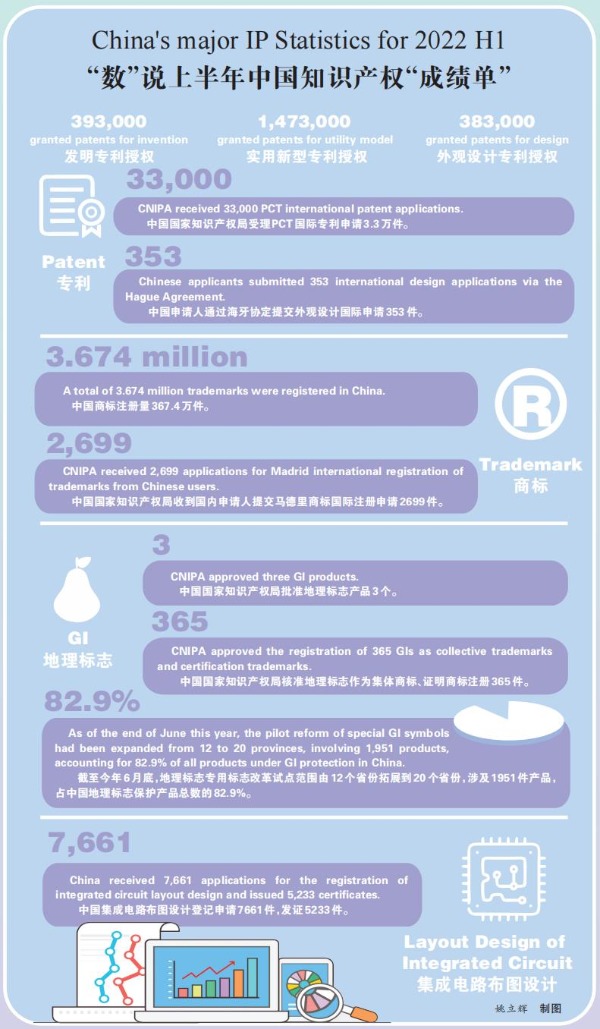2022 H1 IP Statistics:Confidence of Foreign Investors Boosted in Doing Business in China
Source:China IP News
As of the end of June this year, market entities from more than 200 countries or regions owned valid registered trademarks in China, among which those from the United States, Japan, Germany, United Kingdom and South Korea had the largest numbers, showing foreign investors are more confident in doing business in China. Overseas grant of China's invention patents is showing a positive development trend. More and more IPRs are developed independently by China, especially in the fields of emerging technologies including digital economy. The new progress made indicating China's interactions with the rest of the world in IP captured prevalent attention at a SCIO (State Council Information Office) press conference on IP statistics of the first half of 2022 on July 12.
"Generally speaking, IP development in China is moving forward at a steady pace with better quality," said Hu Wenhui, Deputy Commissioner of the China National Intellectual Property Administration (CNIPA). This year, CNIPA has adhered to the principle of seeking progress in stability, launched a number of policies and measures to help enterprises out of difficulties while inspiring their innovation vitality. These policies and measures have led to positive results. IP data reveal steady trend of IP development, robust innovation vitality of domestic enterprises, more inclusive financing by pledging patent and trademark as collaterals, expanded geographical indication industry, and ramped-up patent reserves in the fields of emerging technologies.
Policies launched to help enterprises out of difficulties
Since the outbreak of the COVID-19 pandemic, operations of small and micro enterprises and self-employed households/people in catering, culture, tourism and other industries have been affected. To help enterprises out of difficulties, CNIPA, in May this year, issued the Notice on Accelerating the Launch of More Effective IP Policies to Promote Steady and Healthy Economic Growth, listing 12 specific measures in four aspects so as to provide strong support for steady and healthy economic growth.
The CNIPA has postponed the collection of annual patent fees, so as to directly alleviate the financial burden on market entities; made mechanisms of priority examination of patents, rapid examination of application for trademark registration, and pilot for rapid settlement of disputes in IP Protection Center; worked harder to publicize and promote the Hague Agreement, and encouraged innovators to upgrade the efficiency of making global layout of design; continued to provide financing service to enterprises in industrial park with IP as pledges, so as to upgrade financing support for SMEs; carried out "IP Service Travel Campaign" and opened IP service tools to market entities free of charge. With these measures, IP policies are put into effect in a more speedy and effective way, so as to boost the confidence of market entities to innovate.
Hard work got paid off. Data reveal that in 2022 H1, applications for patents, trademarks and other IPRs in China remained at a stable growth rate. CNIPA received 33,000 PCT international patent applications, and Chinese applicants submitted 353 international design applications via the Hague Agreement. CNIPA received 2,699 applications from Chinese users for Madrid international registration of trademarks and approved 2,239 market entities to use special GI symbols.
Open wider to promote cooperation and win-win
As more and more Chinese innovators go abroad to participate in international competition and cooperation, topics such as "how to obtain overseas patent rights for invention" and "how to ensure cross-border protection of IP" became a focal point of the press conference.
"Overseas grant of Chinese patents for invention has shown a positive trend, heralding a good start in the 14th Five-Year Plan period," said Ge Shu, Director General of CNIPA's Strategic Planning Department. The 14th Five-Year Plan for Protection and Use of IP in China included the number of overseas-granted patents for invention as a major indicator, so as to guide market entities to pay greater attention to the development of overseas patents. According to the data, in 2021, Chinese users obtained 46,000 patents after substantive examinaiton in major countries and regions, up 14.1% year-on-year.
Emerging technology fields including digital economy constitute an important source of overseas patent reserves of Chinese applicants. "The Chinese market entities are using the international IP system to intensify the efforts of protecting overseas IPRs, in particular in fields including digital technologies and biotechnology," said Ge. As of the end of 2021, there were 977,000 valid patents for invention in the core industry of digital economy, accounting for 35.2% of all valid invention patents in China. Taking AI as an example, in 2021, China obtained 57,000 AI invention patents combined from the world's five major IP offices in China, the United States, Europe, Japan and South Korea, with an average annual growth of 38.5%.
"Next, CNIPA will continue to tap the potential of IP policies and provide better services to help prevent and control the COVID-19 pandemic, and boost economic growth," said Hu.

